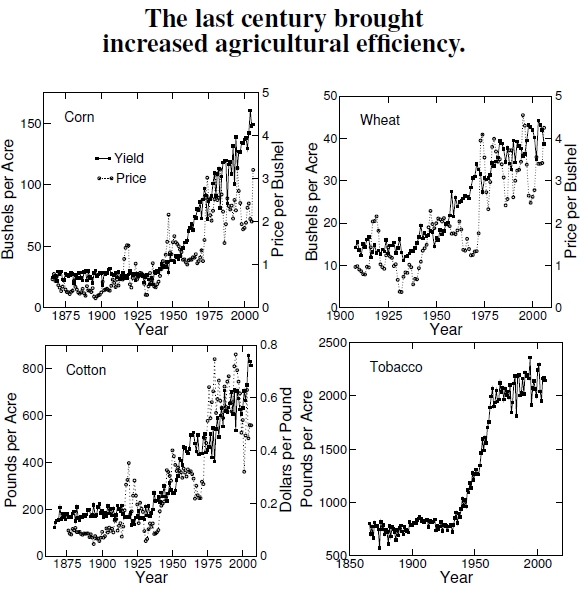1. 5 Increased Crop Yields
 Figure 1.5: These four plots show the yields and prices in the United States for corn, wheat, cotton, and tobacco (without price). Yields per acre (filled squares) increased dramatically, whereas the price per bushel (open circles) exhibits somewhat smaller increases with greater variability (data from www.nass.usda.gov/QuickStats).
Figure 1.5: These four plots show the yields and prices in the United States for corn, wheat, cotton, and tobacco (without price). Yields per acre (filled squares) increased dramatically, whereas the price per bushel (open circles) exhibits somewhat smaller increases with greater variability (data from www.nass.usda.gov/QuickStats).
More people should mean more food eaten, meaning more farmland needed. Instead, farmers grow crops much more efficiently today than just a few decades ago[16] with six times higher crop yields. Despite an increased population demanding more food, Figure 1.7 shows that U.S. farmland has held mostly steady over the last 60 years. We can feed all these people precisely because we’ve modified and engineered a few other species’ productivities. Mechanical, environmental, and biological engineering[17] supports our huge population.
I grew up on a farm and can put Figure 1.5 into a personal context. One of my uncles recalled how his Minnesota family traded in their team of workhorses for their first tractor in 1941, right when crop yields take off. In fact, my brothers and I never had a horse while growing up because my late father–a fantastic mechanic–disliked horse chores as a child. The rejection of horse power in favor of fossil fuel power keeps people fed.
The U.S. Department of Agriculture (USDA) estimated that a farm needs $250,000 in annual crop or livestock production to break even (see Figure 1.7), that is, just to have income meet expenses.[18] What does that number mean to city people? Let’s assume corn was priced at a historically high $3 a bushel,[19] ignoring very recent, and very transient, off-the-axis prices from the biofuels push, and a great yield of 150 bushels an acre.[20] What sized farm earns a farmer a quarter-million dollar gross income? The answer is more than 550 acres of land producing corn, nearly 2,000 acres producing wheat, or about 400 acres producing cotton. In contrast, Durham County farms average just 100 acres.
Are farmers economically sensible? Consider just the land assets involved in a corn-producing farm. If the farmland is worth $5,000 an acre, then its total value is $2.75 million, and that huge asset, not counting equipment, fuel, and labor, provides only a break-even return. On paper, the United States has millionaire farmers who can’t make a living. A farmer could (an investment adviser might say should) sell all his or her land, invest it in mutual funds with a 10% annual return,[21] and make $275,000 per year without backbreaking 16-hour workdays. The advice doesn’t strongly depend on these figures: Divide the land price by two and the numbers remain astonishing. I’m surprised we have any farms at all in the United States. Essentially, farmers provide volunteer labor, not to mention a public service. Local, organic, and small-scale farming methods gained popularity recently, but it seems questionable that we can afford to scale back the increased food production efficiency from the last century. Certainly these interests can reenergize small farms and, perhaps, even prompt gardening by city dwellers.
Let’s now examine the origins and consequences of these yield gains.
——————————————————
[16] Crop yield and price data comes from www.nass.usda.gov/QuickStats.
[17] When I use the phrase “biological engineering,” I’m also thinking about old-fashioned plant breeding. Certainly we recently developed much better ways of putting desired traits into many types of organisms, but people have been doing that for a long time.
[18] MacDonald et al. (2006) provide the USDA farm breakeven numbers.
[19] A U.S. bushel is an 8-inch-deep cylinder of diameter 18.5 inches, a volume of just over 35 liters, and is equal to 4 pecks. It is now defined as a specific mass or weight of the commodity in question; for shelled corn that weight is 56 pounds at 15.5% moisture content.
[20] An acre equals 4,840 square yards, 43,560 square feet (a square about 209 feet on each side), or about 4,046 square meters. One square mile contains 640 acres, equal to a section. An acre also equals a chain (22 yards) by a furlong (220 yards). An acre just outsizes a football field, and a city block covers about 4 acres. Finally, 1 hectare is a square 100 meters on a side and equals 2.47 acres, and 100 hectares equals one square kilometer.
[21] This idea of 10% annual returns was written before fall 2008, before the collapse of the stock market.